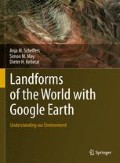Abstract
In 1980, father and son geologists Luis and Walter Alvarez discovered unusually high traces of iridium in rock layers near Gubbio (Italy) that define the Cretaceous-Paleogene boundary (K-Pg; formerly known as the K-T boundary) when about 75 % of all species on Earth, including the dinosaurs, perished forever in a mass extinction event. The Alvarez’s put forward an extraordinary claim – that the accumulation of this much iridium-bearing dust would require an asteroid of about 10 km wide to hit the Earth. The search was on. But it proved to be difficult for two reasons: First, the event took place 65 million years ago and the crater could have been eroded or filled with sediments. And secondly, most of the Earth’s surface is covered with water making it difficult to detect craters on the ocean floor. A decade later, geologists and geophysicists searching for oil finally found a huge crater that fit the search criteria. It was almost 200 km in diameter and 1.5 km deep, but buried under sediments near a town called Chicxulub on Mexico’s Yucatán Peninsula. Chicxulub means “tail of the devil” in the local Mayan language. Today, almost all scientists agree that this gigantic asteroid impact produced a blast 6 million times more powerful than the 1980 eruption of Mt. St. Helens and caused a cataclysmic collapse of ecosystems that lead ultimately to the K-Pg mass extinction. The last piece of the puzzle was put together in 2013, when researchers provided new evidence that the age of the Chicxulub asteroid impact and the K-Pg boundary coincide precisely. This short chapter presents a few visual examples of impact craters that are visible on the face of the Earth and explains why they are so scarce and rarely preserved on Earth.
Access this chapter
Tax calculation will be finalised at checkout
Purchases are for personal use only
Further Readings
Alvarez LW, Alvarez W, Asaro F, Michel HV (1980) Extraterrestrial cause for the cretaceous-tertiary extinction. Science 208:1095
Bobrowsky PT, Rickman H (eds) (2007) Comet/asteroid impacts and human society: an interdisciplinary approach. Springer, New York
Earth Impact Database (2010) Planetary and space science center. University of New Brunswick, Canada. http://www.passc.net/EarthImpactDatabase/
Hamacher DW (2011) Meteoritics and cosmology among the Aboriginal cultures of central Australia. J Cosmol 13:3743–3753
Hamacher DW (2012) On the astronomical knowledge and traditions of aboriginal Australians. Doctor of Philosophy thesis, Department of Indigenous Studies, Macquarie University, Sydney
Koeberl C (2002) Mineralogical and geochemical aspects of impact craters. Mineral Mag 66(5):745–768
Lissauer JJ (1999) How common are habitable planets? Nature 402:C11–C14
Melosh HJ (1989) Impact cratering – a geologic process. Oxford University Press, New York
Piccardi L, Masse WB (2007) Myth and geology, Special Publications, 273. Geological Society, London. doi:10.1144/GSL.SP.2007.273.01.26
Renne PR, Deino AL, Hilgen FJ et al (2013) Time scales of critical events around the cretaceous-paleogene boundary. Science 339:684
Author information
Authors and Affiliations
Rights and permissions
Copyright information
© 2015 Springer Science+Business Media Dordrecht
About this chapter
Cite this chapter
Scheffers, A.M., May, S.M., Kelletat, D.H. (2015). Impacts Craters. In: Landforms of the World with Google Earth. Springer, Dordrecht. https://doi.org/10.1007/978-94-017-9713-9_5
Download citation
DOI: https://doi.org/10.1007/978-94-017-9713-9_5
Published:
Publisher Name: Springer, Dordrecht
Print ISBN: 978-94-017-9712-2
Online ISBN: 978-94-017-9713-9
eBook Packages: Earth and Environmental ScienceEarth and Environmental Science (R0)

